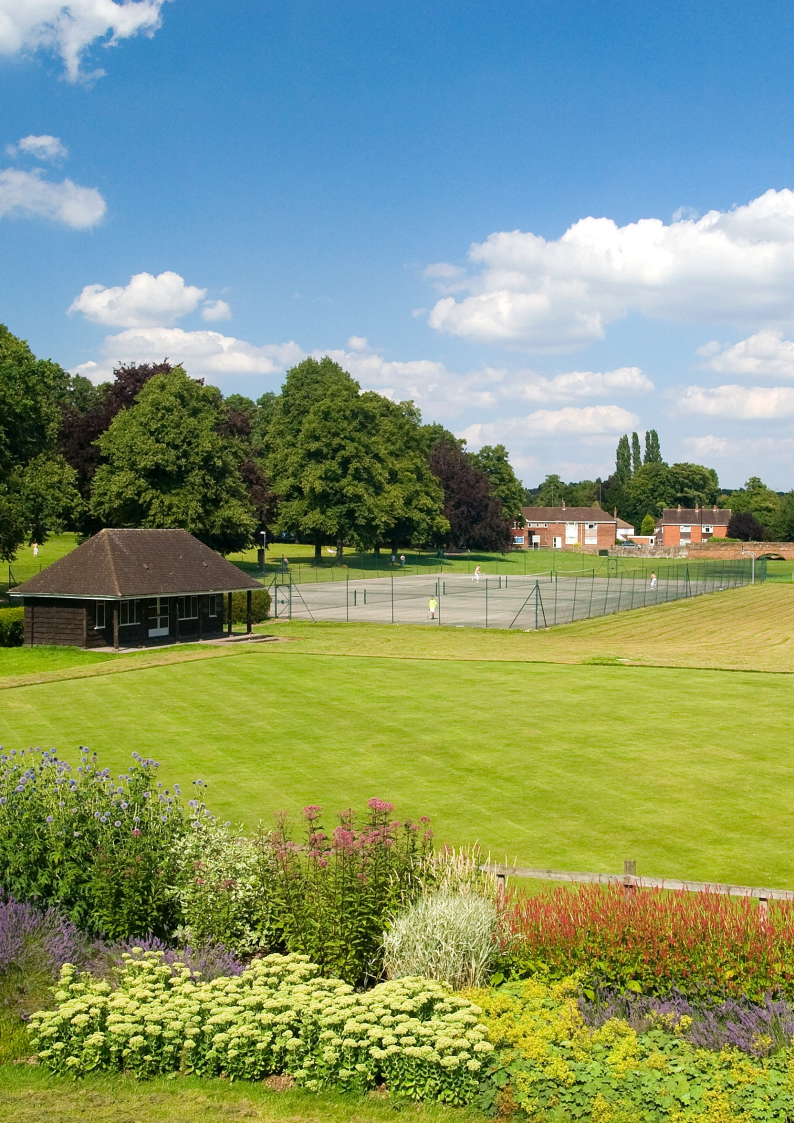BASE HEADER
Public Open Spaces
(9) SECTION 2
Public Open Space Requirements
Residential Developments
On all residential developments of 11 or more dwellings* there will be a requirement for public open spaces provision in accordance with the standards specified in this SPD. The District Council will expect developers to meet the overall open space requirement; however it may apply a degree of flexibility to the individual types of space having regard to the Parks and Open Space Audit and the particular circumstances of the development site in question.
Where it is demonstrated that it is impractical or inappropriate to provide open space physically on-site, the District Council may consider commuting the requirement to an alternative location provided that it is within reasonable walking distance of the development. A distance of 480 meters approximately a 10 minutes' walk is considered appropriate for this purpose.
Where neither an on-site nor off-site location is available or considered appropriate to serve the development, a financial contribution from the developer as a means of providing qualitative improvements to existing open space will be required. The form of any contribution will be guided by the findings of the District's Parks and Open Spaces Audit and any other material evidence.
In instances where off-site financial contributions are proposed, the Council will endeavour to ensure that any qualitative improvements are within a reasonable distance of the development.
Where a developer makes the physical provision of new open space it will be delivered to an agreed standard, as detailed in this SPD. It is the authority's expectation that the public open space will be offered to the Council for adoption.
Commercial Developments
New commercial or industrial developments will create demand for public open space through their workforce. Such open space will need to be available on site so that employees can take advantage of it during their working day. The provision will focus on amenity open space, parks and gardens and accessible natural areas, with no need to provide allotments or youth areas. Smaller developments that will employ less than 100 full-time equivalent employees will be exempt.
* any subsequent changes to national planning policies that alter the minimum number of dwellings that such an obligation can apply to will be used
The Public Open Space Standard – Residential developments
In order to maintain the current average provision of POS, a minimum of 5.47ha of unrestricted public open space will be required per 1000 head of population. The proportion of this space given to each of the 5 typologies is as follows:
For the avoidance of doubt POS must be useable by the public. Thus non-useable landscaping such as 'SLOAP' (space left over after planning) will not count towards the standards. For example, roadside verges would not count but areas where dogs could be walked or people could sit or children play informally would contribute.
Amenity Green Space: 17%
Opportunities for informal activities close to home or work. They are important for the enhancement of the appearance of residential or other areas but are not laid or managed for specific formal functions, such as a sports pitch. Road side verges and similar spaces do fulfil the function of amenity green space.

Parks and Gardens: 35%
Accessible, high quality opportunities for informal recreation and community events. These include urban parks, formal gardens and country parks.
Natural Areas including Urban Woodland: 35%
These areas are principally aimed at protecting and enhancing wildlife conservation, biodiversity and environmental education and awareness through environments such as urban woodlands, grasslands, wetlands and wildflower meadows.
Allotments, Community Gardens and Urban Farms: 7%
Opportunities for those who wish to grow their own produce as part of the long term promotion of sustainability, health and social inclusion.
Children / Youth Areas: 6%
Areas designed primarily for play and social interaction and young people, such as equipped play areas, ball courts, skateboard areas and teenage shelters.
Sites of over 100 dwellings will be required to provide a further amount specifically for allotments of 0.42ha per 1000 head of population.
The Public Open Space Standard –
Commercial and Industrial developments
In order to provide public open space for the benefit of employees, a minimum of 2.5ha of unrestricted public open space will be required per 1000 employees. Developments that result in less than 100 f/t equivalent employees will be exempt. The proportion of this space given to each of the 5 typologies is as follows:
Amenity Green Space: 20%
Opportunities for informal activities close to home or work. They are important for the enhancement of the appearance of residential or other areas but are not laid or managed for specific formal functions, such as a sports pitch. Road side verges and similar spaces do fulfil the function of amenity greenspace.
Parks and Gardens: 40%
Accessible, high quality opportunities for informal recreation and community events. These include urban parks, formal gardens and country parks.
Natural Areas including Urban Woodland: 40%
These areas are principally aimed at protecting and enhancing wildlife conservation, biodiversity and environmental education and awareness through environments such as urban woodlands, grasslands, wetlands and wildflower meadows.
Allotments, Community Gardens and Urban Farms: 0%
Opportunities for those who wish to grow their own produce as part of the long term promotion of sustainability, health and social inclusion.
Children / Youth Areas: 0%
Areas designed primarily for play and social interaction and young people, such as equipped play areas, ball courts, skateboard areas and teenage shelters.
How the standards should be applied
Calculating the quantum of open space to be provided Residential
The amount of land required to meet the standard is determined by first calculating the population of the proposed development. For residential developments this is worked out by taking the number of bedrooms in each dwelling provided in the development as the head of population, with the exception of one bedroom dwellings which will be assumed to have 1.5 people. For student housing, the number of students to be accommodated will be used
To calculate the total open space required, divide the number of people from the development (see above) by 1000 and then multiply by the open space standard of 5.47 (hectares)
In relation to housing schemes that are to particularly meet the needs of the elderly then contributions for parks and gardens and amenity open space will be the Council's main focus. This means that the proportions of allotment and play areas may be reduced whilst increasing the other public open space typologies in order to maintain the required quantum
In relation to other adult care schemes, flexibility will be afforded in the ratio of the various typologies of open space, for example to provide greater gardening opportunities, as long as the overall quantum required is met.
Apart from the exceptions mentioned above, developments over 100 dwellings will be required to provide allotments on-site, or make alternative provisions within 480 metres of the site. Sites adjacent to one another combining provision in one area will be encouraged to help deliver effective allotment sites. Allotment provision is a statutory duty of the council and less flexibility will be afforded to non- provision when the threshold is reached.
Commercial and Industrial
The amount of land required to meet the standard is determined by first calculating the full-time equivalent jobs of the proposed development.
To calculate the total open space required, divide the number of full-time jobs from the development by 1000 and then multiply by the open space standard of 2.5 (hectares)
Calculation of Commuted Sum for maintenance of public openspaces
Arrangements will need to be made for the maintenance and management of any POS, and this will require the payment of a commuted sum to the District Council. This will involve a site-specific calculation of the annual maintenance costs over a period of twenty years, taking into account the various components that make up the open space, plus a 28% management fee to managing the maintenance
Broadly indicative costs are produced periodically by the authority in order to offer guidance to developers, and such a document is appended to this SPD as Appendix 3. However, each site is unique in requirement and costs, and the provided information should be regarded as advisory only, with definitive calculations produced at the point of application. The provision of such a calculation is dependent upon the provision of a detailed POS Scheme that demonstrates not only the quantum of POS to be provided but also visibly determines the specific provision of the various typologies and management prescriptions.
Calculation of the capital off-site sum
The sum calculated for each type of open space where full provision is not made on site will be based on the estimated cost of creating the public open spaces (and subsequent maintenance costs over a twenty year period). Guidance is provided in Appendix 3.
In order to maintain the high quality of public open spaces that is currently prevalent in the District, and to ensure that maintenance and enhancement can take place seamlessly in the future, it is expected that developers will offer POS land to be adopted by the District Council, along with a suitable commuted sum for future maintenance. In the event that the POS is passed to another party to maintain, the provisions laid out in Appendix 7 should be adhered to.
Administering the System
With regard to the on-site provision of public open spaces a Commuted Sum for maintenance is to be paid to the District Council upon formal land adoption by the authority.
Formal Local Authority adoption of POS will only take place when the Council considers that the POS has reached an acceptable standard upon practical completion and any commuted sum for maintenance has been received.
Off-site Provision Capital Sums will be spent on open space improvements identified by the Council as part of the Section 106 agreement. Improvements to open space shall include; the creation of new areas where there is a deficiency; raising existing standards and adding value to an area in terms of the leisure experience on offer.
In addition to the commuted sum, applicants will be expected to pay the Councils legal costs involved in making the planning obligation.
